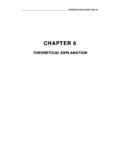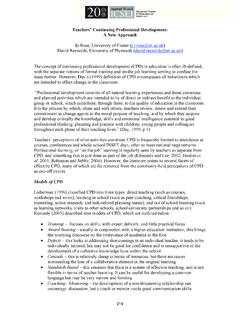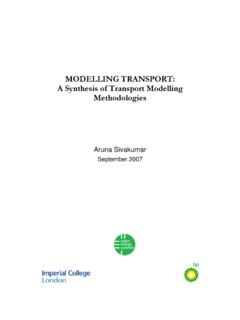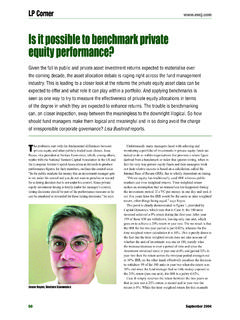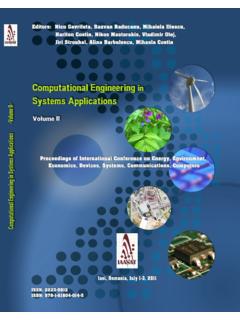Transcription of Economic analysis of animal diseases
1 ISSN 1810-0708. 18. FAO animal PRODUCTION AND HEALTH. guidelines Economic analysis . OF animal diseases . Cover photographs Left: FAO/Asim Hafeez Center: FAO/Giulio Napolitano Right: FAO/Cecilia Ballesteros 18. FAO animal PRODUCTION AND HEALTH. guidelines Economic analysis . OF animal diseases . FOOD AND AGRICULTURE ORGANIZATION OF THE UNITED NATIONS. Rome, 2016. Recommended Citation FAO. 2016. Economic analysis of animal diseases . FAO animal Production and Health Guidelines. No. 18. Rome. The designations employed and the presentation of material in this information product do not imply the expression of any opinion whatsoever on the part of the Food and Agriculture Organization of the United Nations (FAO) concerning the legal or development status of any country, territory, city or area or of its authorities, or concerning the delimitation of its frontiers or boundaries. The mention of specific companies or products of manufacturers, whether or not these have been patented, does not imply that these have been endorsed or recommended by FAO in preference to others of a similar nature that are not mentioned.
2 The views expressed in this information product are those of the author(s) and do not necessarily reflect the views or policies of FAO. ISBN 978-92-5-109166-1. FAO, 2016. FAO encourages the use, reproduction and dissemination of material in this information product. Except where otherwise indicated, material may be copied, downloaded and printed for private study, research and teaching purposes, or for use in non-commercial products or services, provided that appropriate acknowledgement of FAO as the source and copyright holder is given and that FAO's endorsement of users' views, products or services is not implied in any way. All requests for translation and adaptation rights, and for resale and other commercial use rights should be made via or addressed to FAO information products are available on the FAO website ( ). and can be purchased through iii Contents Preface vii Acknowledgements ix Acronyms xi Glossary of technical terms xiii 1.
3 BACKGROUND 1. 2. INTRODUCTORY MATERIAL 3. What is a transboundary animal disease? 3. Why Economic analysis is applied to TADs 3. 3. A FRAMEWORK FOR analysis 7. Overall framework 7. Economic impact of a TAD 7. Economic viability of an intervention to prevent or control a TAD 10. Motivation for stakeholders to comply with TAD control regulations 12. Identification of stakeholders 13. 4. Economic IMPACT OF A TAD 17. Sources of impact 17. Disease effects 17. Market disruption 18. Prevention and control measures 23. Impacts beyond the livestock sector 24. Examples of global analyses 28. Examples of national/sector level analysis 28. Comparison of national statistics 29. Macroeconomic modelling 30. Simulation modelling 31. Examples of stakeholder-level assessments 31. Simulation modelling 33. Sustainable livelihoods analysis 33. Comparing estimates of Economic impact 36. 5. Economic VIABILITY OF INTERVENTIONS 37.
4 Sources of benefit within the livestock sector 37. iv Increased output and asset value 37. Reduced prevention and treatment costs 39. Sources of benefit to public health 39. Sources of cost within the livestock sector 39. Prevention and preparedness costs 39. Outbreak control costs 42. Opportunity costs of management and system changes 43. Examples of analyses at global/regional/national level 44. Cost-benefit analysis 44. Cost-effectiveness analysis 46. Other methods 47. Economic analysis as part of a risk analysis 49. Example of analyses at sub-national level 50. Cost-benefit analysis 50. Cost-effectiveness analysis 51. Partial budget analysis 51. Other methods 52. 6. MOTIVATION TO COMPLY WITH TAD CONTROL REGULATIONS 55. Perception of risk 55. Economic analysis 57. 7. DESIGNING AN Economic analysis 59. Describing what needs to be done 59. Start early 59. Frame the question 59. Specify the work 60.
5 Plan for feedback 60. Data needs and data deficiencies 60. Livestock population size and structure 61. Disease incidence and impact on production parameters 61. Profitability of livestock production and trade 62. Consumption of livestock products 62. Quantified relationships between the livestock sector and other sectors of the economy 62. REFERENCES 63. v LIST OF TABLES. 1. Overall framework 7. 2. Methods for estimating the Economic impact of a TAD 8. 3. Methods for estimating the Economic viability of an intervention 11. 4. Classification of costs of TAD prevention and control interventions 12. 5. Classification of benefits of TAD prevention and control interventions 12. 6. Methods for analysing motivation to comply 13. 7. Some estimates of the impact of TADs 35. LIST OF FIGURES. 1. Context and sources of the impact of a TAD 9. LIST OF BOXES. 1. A quick guide to the value chain approach 15.
6 2. Examples of losses from disease experienced by livestock owners 18. 3. Market shocks caused by H5N1 HPAI 20. 4. Examples of impacts associated with trade restrictions 22. 5. An example of the impact of prevention and control measures 24. 6. Examples of TAD impacts beyond the livestock sector 26. 7. Four pillars of food security 27. 8. Global Economic impacts 29. 9. Macroeconomic effects of H5N1 HPAI and rinderpest 30. 10. Impacts of TADs estimated using macroeconomic models 32. 11. Examples of the impact of TAD prevention and control measures on livelihood assets 34. 12. Benefits from increased output value 38. 13. Collateral benefits 40. 14. An example of human health benefits from TAD control 42. 15. Per- animal costs of vaccination 43. 16. Lost production value resulting from outbreak control 44. 17. Opportunity costs of management and system changes 45. 18. Assessment of Economic viability using cost comparison 48.
7 19. Use of Economic techniques within a risk analysis framework 48. 20. Cost-benefit analysis for CSF vaccine supply through a distributor 50. 21. Impacts of TADs control on different stakeholders 51. 22. Cost-effectiveness of rabies control in N'Djamena 52. 23. Partial budget analysis for application of CSF vaccination in a Vietnamese smallholder pig herd 53. 24. Risk perception and Economic impact 56. 25. Principal-agent relationships and the design of compensation schemes 58. vii Preface One of the promises of medicine is the promotion of health and the prevention of disease. While the adage that prevention is better than cure' is a hallmark for addressing problems early and avoiding costly efforts for recovery and rehabilitation, the truth is that we do not invest sufficiently in prevention. Prevention is a difficult sale' but an important message for transboundary animal disease control, and one that will need to be supported by strong Economic evidence.
8 A veterinary approach to transboundary animal diseases focuses on controlling disease in the affected animal or livestock population, ignoring the fact that livestock owners and society as a whole are affected by the impacts of diseases and the measures taken to con- tain them. Economic analysis is a discipline that can help to close this gap by supporting stakeholders in assessing whether a particular investment on the prevention or control of a transboundary animal disease (TAD) is likely to result in an overall benefit for society, and what the associated investment might be. These guidelines are designed for professionals and technicians who recognize or wish to better understand the importance of Economic studies to justify (or not) the use of public funds and those of private investments in the prevention, control and management of trans- boundary animal diseases . The impacts of these diseases can be wide-ranging, including the immediate loss of livelihood to those in the livestock sector, disruption of domestic trade or the cessation of access to international markets, and threats to public health.
9 The guidelines are also helpful for an individual to better interpret Economic studies already undertaken and to obtain greater insight into what was included in the analysis , how and why. While having a standard methodology would, arguably, be an ideal, it is not a realistic aim, given the wide range of questions to be addressed and the Economic techniques avail- able to analyse them. The guidelines provide a framework for conducting Economic analysis for different purposes and provide an introduction to the language, techniques, assump- tions, and approaches of animal health economics, rather than proposing a prescriptive method. It is anticipated that the guidelines will encourage productive dialogue when ani- mal health issues are discussed with economists and will encourage fruitful, well-informed collaboration between veterinarians, animal health experts, economists and social scientists.
10 The impact of transboundary animal diseases under endemic settings or their incursion into free regions is of great concern in protecting efficiencies in animal production, ensuring availability of quality nutrition and food security to the communities, and achieving resilience and prospects for poverty reduction, and in the stability of markets. animal health practitioners often have difficulty in communicating the importance of their work in safeguarding animal production, the safety of the food chain, and the eco- nomic value of the industry large and small as well as in their own ability to mobilize the required financial or human resources for their work in disease management, research in vaccine development, diagnostic networks and bio-surveillance, pathogenesis, contingency viii funds well-honed responses, or border protection. The key to successful resource mobi- lization would be the incorporation of substantive Economic evidence and the rationale for such investment.











